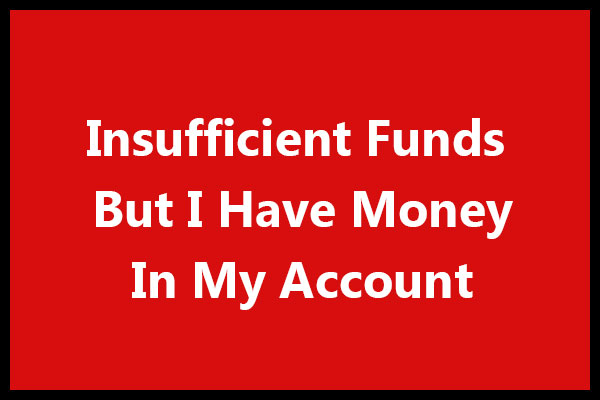Seeing “insufficient funds” on your bank account or at an ATM can be frustrating—especially if you know you have money. In the U.S., this usually happens because of holds, pending transactions, or differences between your account balance and your available balance.
This guide explains what “insufficient funds” means, why it happens, and what to do if it occurs.

Table of Contents
What Does “Insufficient Funds” Mean?
When you see “insufficient funds,” it means your available balance is too low to cover a transaction.
Available balance = money you can immediately use.
Current (or ledger) balance = all money in your account, including funds that may not be cleared yet.
Banks check your available balance at the moment a transaction is authorized. If there isn’t enough, the transaction will be declined or may trigger an overdraft.
According to the Consumer Financial Protection Bureau (CFPB), insufficient funds fees (often called NSF fees) are charged when a bank refuses a transaction due to a lack of available funds.
What Does Insufficient Mean?
Insufficient means not enough. It is the opposite of sufficient. In other words, insufficient means not enough. It is the opposite of sufficient.
The word insufficient can be used in many different contexts. For example, if someone does not have enough money, they could be described as insufficiently wealthy. If a person does not have enough food, they could be described as insufficiently nourished.
Why You Might Get “Insufficient Funds” Even If You Have Money
1. Pending Deposits or Holds
-
Check deposits: Banks often place a temporary hold on check deposits to ensure the check clears. Under Federal Reserve Regulation CC, the first $225 of a check must usually be available the next business day, but the rest may be held for several days.
-
Mobile deposits: Holds can be longer, especially for large or out-of-state checks.
-
Direct deposits: Usually clear faster, but may still post later in the day depending on employer and bank processing.
2. Debit Card Holds
Gas stations, hotels, and rental car companies often place authorization holds that temporarily reduce your available balance, even if the final charge will be lower.
3. Pending Payments or Pre-Authorizations
When you swipe your card, the merchant requests authorization. This lowers your available balance immediately—even if the transaction hasn’t fully posted yet.
4. Overdraft Protection or Linked Accounts
If you opted out of overdraft protection, transactions that exceed your available balance are declined. If you opted in, your bank may approve the charge but apply overdraft fees (often $30–$35 per transaction).
5. Returned or Bounced Deposits
If a check you deposited bounces, the bank removes those funds, which may create a negative balance and trigger “insufficient funds” on new transactions.
Find out what K means in number terms
Common Scenarios
-
ATM withdrawal denied: You see a balance in your app, but funds are on hold.
-
Debit card declined at store: A pre-authorization hold already reduced your available balance.
-
Check returned unpaid: The check issuer had insufficient funds in their account, so your deposit was reversed.
Check out how many pennies in a roll
What To Do If This Happens
-
Check your available balance (not just the current balance) in your bank’s mobile app or online portal.
-
Review pending transactions to see what holds or pre-authorizations are reducing your balance.
-
Contact your bank if you believe funds should be available. Ask about hold policies or release times.
-
Opt into account alerts so you’re notified when your available balance is low.
-
Keep a buffer in your checking account to cover unexpected holds or delays.
Insufficient Funds Fees in the U.S.
-
NSF (Non-Sufficient Funds) fees are charged when a transaction is declined.
-
Overdraft fees are charged if the bank covers a transaction when your balance is too low.
-
In 2023, many U.S. banks (including Capital One, Ally, and Citibank) reduced or eliminated NSF fees after regulatory pressure. Check your bank’s policy.
See: CFPB – Bank Fees
In the U.S., “insufficient funds” usually happens because of differences between available balance and actual account balance, along with holds, pending deposits, or pre-authorizations.
If you know you have money but your bank says otherwise, always check:
-
Has a deposit cleared?
-
Are there pending transactions or holds?
-
Does your bank have overdraft settings affecting the transaction?
The safest approach is to monitor your available balance, maintain a buffer, and understand your bank’s policies.
Key Takeaway: You may see money in your account, but that doesn’t always mean it’s available for use.

